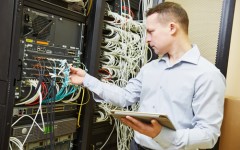UPS technology in the home – What can it do for you
Power interruption protection is vital for just about any professional. If you are on the phone with an important client, but your power system is disrupted by something as small as a blown fuse or surge, then you call get disrupted and the relationship is damaged. If you're working on a critical spreadsheet and have a similar event take place, the updates you are making could be lost. When you think of uninterruptible power supplies, you may think of data centers, hospitals and similar facilities that handle large quantities of mission-critical data. However, the rise of remote work is creating an operational climate where putting a small UPS in homes could prove incredibly important for businesses.
Research from the Bureau of Labor Statistics found that approximately 24 percent of all people holding a job in the United States do at least some of their work from home. What's more, that figure is made up primarily of individuals in professional roles.
In other words, as the economy is moving toward more information-focused professional jobs, more people find themselves able to engage in flexible work environments. Cloud computing, widespread mobile device use and the proliferation of web apps have come together to help people work where they want, when they want. However, that doesn't necessarily mean that today's professionals are fully prepared to work from home, and power-related problems are a major issue here.

Understanding the WFH power problem
In traditional operating models, businesses put technology in place to ensure reliability and high levels of availability for employees. Uninterruptable power supply systems designed for enterprise data centers and office settings are commonly used to ensure people have reliable power, even if consistent energy delivery gets a bit inconsistent. When people start working from home, these pre-built support systems start to disappear.
A CNET report explained that power problems, ranging from brownouts to downed lines, are a reality even in our modern world. This creates major issues for computers and other data-focused devices, and employees can't afford to neglect having a backup power source in place in the event that their primary energy system falters. UPS technologies are central to success here, and they actually work fairly simply.
"Employees can't afford to neglect having a backup power source in place."
Most UPS solutions designed for home use will serve as a go-between along the power deliver line, CNET said. This means that the UPS setup will capture AC power from wall outlets, convert it to DC power to store in a battery, then trickle AC power back out for devices. A UPS may look like a fancy surge protector or a small box in between the wall outlet and your computer, but it is ultimately a highly refined energy storage system that provides backup functionality in the event of surges, outages or similar problems. When the power goes out for any reason, the UPS simply shifts over to its stored energy to meet demand, allowing for continued operations as if nothing happened.
If you are considering working from home or having employees do so while handling critical processes, you must evaluate how you will offer backup power. While expecting workers to have alternative location options in place in the event of an extended outage – such as cafes or libraries – is a good first step, this may not protect against immediate data loss if an outage or surge causes problems. A UPS will offer full security in the event of these sorts of problems and buy users the time they need to finish up any work tasks and get to a reliable location in the event of downtime.
Making the most of what UPS technology can offer
Identifying exactly how long a UPS will last without any incoming energy is a difficult matter that involves using data about your specific operational environment with the battery life of the UPS. What's more, you must also consider how quickly the battery can recharge. Imagine a day when it is snowing outside. A fallen branch leads to an outage for half an hour in your neighborhood and you work as if nothing happened because your UPS is in place. However, by the end of the half an hour you only a little more than half the battery left. Understanding how quickly your UPS can recharge is just as important as knowing how long you can expect it to last.
"UPS technologies designed for home use provide simple, cost-efficient continuity."
Ultimately, a UPS should be a part of a backup and continuity strategy for remote workers. It isn't the only solution you need – extended outages and similar issues will require other layers of planning. However, a UPS provides vital insurance against the seemingly minor, normal power delivery issues that may cause lights to flicker and computers to restart.
These types of problems would normally only derail work for a couple of minuets, so your employees may not be thinking about them when they start to work from home. Then, a 30-second outage hits when somebody is updating a database and the information gets corrupted. This type of disruption, whether it ends up being internal or happening with customer-facing interactions, needs to be avoided if at all possible.
UPS technologies designed for home use provide simple, cost-efficient continuity options for businesses that want to take advantage of the remote work movement. Don't just empower your employees to get the job done outside the office, make sure they also have the tools they need to do so efficiently and without disruption.
 Loading... Please wait...
Loading... Please wait... 






